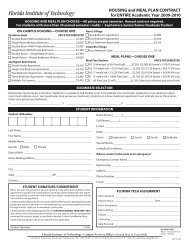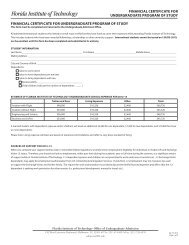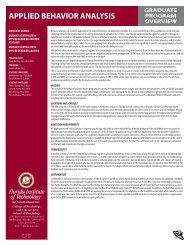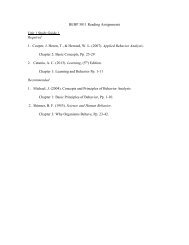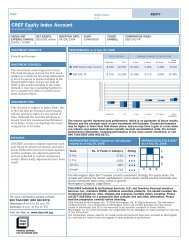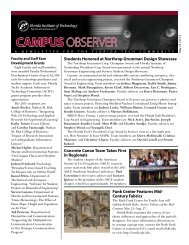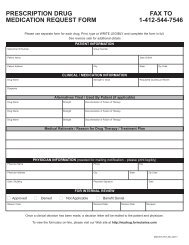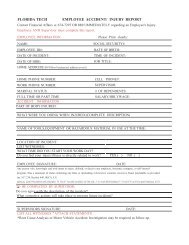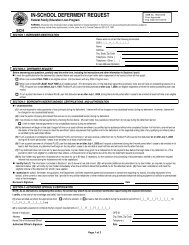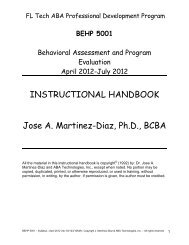Form IT-2104:4/09:Employee's Withholding Allowance Certificate ...
Form IT-2104:4/09:Employee's Withholding Allowance Certificate ...
Form IT-2104:4/09:Employee's Withholding Allowance Certificate ...
You also want an ePaper? Increase the reach of your titles
YUMPU automatically turns print PDFs into web optimized ePapers that Google loves.
Page 2 of 4 <strong>IT</strong>-<strong>2104</strong> (4/<strong>09</strong>)<br />
student under 25. If you are a dependent who is under 18 or a full-time<br />
student, you may owe tax if your income is more than $3,000.<br />
<strong>Withholding</strong> allowances<br />
You may not claim a withholding allowance for yourself or, if married,<br />
your spouse. Claim the number of withholding allowances you compute<br />
in Part 1 and Part 3 on page 3 of this form. If you want more tax withheld,<br />
you may claim fewer allowances. If you claim more than 14 allowances,<br />
your employer must send a copy of your <strong>Form</strong> <strong>IT</strong>-<strong>2104</strong> to the New York<br />
State Tax Department. You may then be asked to verify your allowances.<br />
If you arrive at negative allowances (less than zero) on lines 1, 2, 20, or<br />
31, and your employer cannot accommodate negative allowances, enter 0<br />
and see Additional dollar amount(s) below.<br />
Income from sources other than wages — If you have more than<br />
$1,000 of income from sources other than wages (such as interest,<br />
dividends, or alimony received), reduce the number of allowances<br />
claimed on line 1 and line 2 (if applicable) of the <strong>IT</strong>-<strong>2104</strong> certificate by one<br />
for each $1,000 of nonwage income. If you arrive at negative allowances<br />
(less than zero), see <strong>Withholding</strong> allowances above. You may also<br />
consider filing estimated tax, especially if you have significant amounts of<br />
nonwage income. Estimated tax requires that payments be made by the<br />
employee directly to the Tax Department on a quarterly basis. For more<br />
information, see the instructions for <strong>Form</strong> <strong>IT</strong>-2105, Estimated Income Tax<br />
Payment Voucher for Individuals, or see Need help? below.<br />
Other credits (Worksheet line 13) — If you will be eligible to claim<br />
any credits other than the credits listed in the worksheet, such as an<br />
investment tax credit, you may claim additional allowances as follows:<br />
• If you expect your New York adjusted gross income to be less than<br />
$300,000, divide the amount of the expected credit by 70 and enter the<br />
result (rounded to the nearest whole number) on line 13.<br />
• If you expect your New York adjusted gross income to be between<br />
$300,000 and $500,000, divide the amount of the expected credit by 80<br />
and enter the result (rounded to the nearest whole number) on line 13.<br />
• If you expect your New York adjusted gross income to be over<br />
$500,000, divide the amount of the expected credit by 90 and enter the<br />
result (rounded to the nearest whole number) on line 13.<br />
Example: You expect your New York adjusted gross income to be<br />
less than $300,000. In addition, you expect to receive a flow-through<br />
of an investment tax credit from the S corporation of which you are a<br />
shareholder. The investment tax credit will be $160. Divide the expected<br />
credit by 70. 160/70 = 2.2857. The additional withholding allowance(s)<br />
would be 2. Enter 2 on line 13.<br />
Married couples with both spouses working — If you and your spouse<br />
both work, you should each file a separate <strong>IT</strong>-<strong>2104</strong> certificate with your<br />
respective employers. You should each mark an X in the box Married,<br />
but withhold at higher single rate on the certificate front, and divide the<br />
total number of allowances that you compute on line 20 and line 31 (if<br />
applicable) between you and your working spouse. Your withholding will<br />
better match your total tax if the higher wage-earning spouse claims all of<br />
the couple’s allowances and the lower wage‑earning spouse claims zero<br />
allowances. Do not claim more total allowances than you are entitled to.<br />
If you and your spouse’s combined wages are between $100,000 and<br />
$1,100,000, use one of the charts in Part 4 to compute the number of<br />
allowances to transfer to line 19.<br />
Taxpayers with more than one job — If you have more than one<br />
job, file a separate <strong>IT</strong>-<strong>2104</strong> certificate with each of your employers. Be<br />
sure to claim only the total number of allowances that you are entitled<br />
to. Your withholding will better match your total tax if you claim all of<br />
your allowances at your higher‑paying job and zero allowances at the<br />
lower-paying job. In addition, to make sure that you have enough tax<br />
withheld, if you are a single taxpayer or head of household with two or<br />
more jobs, reduce the number of allowances by six on line 1 and line 2 (if<br />
applicable) on the certificate you file with your higher-paying job employer.<br />
If you arrive at negative allowances (less than zero), see <strong>Withholding</strong><br />
allowances above.<br />
If your combined wages are between $100,000 and $1,100,000, use one<br />
of the charts in Part 4 to compute the number of allowances to transfer to<br />
line 19. Substitute the words Highest paying job for Higher earner’s wages<br />
within the charts.<br />
Dependents — If you are a dependent of another taxpayer and expect<br />
your income to exceed $3,000, you should reduce your withholding<br />
allowances by one for each $1,000 of income over $2,500. This will<br />
ensure that your employer withholds enough tax.<br />
Following the above instructions will help to ensure that you will not owe<br />
additional tax when you file your return.<br />
Heads of households with only one job — If you will use the head-ofhousehold<br />
filing status on your state income tax return, mark the Single<br />
or Head of household box on the front of the certificate. If you have only<br />
one job, you may also wish to claim two additional withholding allowances<br />
on line 14.<br />
Married couples with only one spouse working — If your spouse does<br />
not work and has no income subject to state income tax, mark the<br />
Married box on the front of the certificate. You may also wish to claim two<br />
additional allowances on line 15.<br />
Additional dollar amount(s)<br />
You may ask your employer to withhold an additional dollar amount each<br />
pay period by completing lines 3, 4, and 5 on <strong>Form</strong> <strong>IT</strong>-<strong>2104</strong>. In most<br />
instances, if you compute a negative number of allowances using the<br />
worksheet on page 3 and your employer cannot accommodate a negative<br />
number, for each negative allowance claimed you should have an<br />
additional $2.10 of tax withheld per week for New York State withholding<br />
on line 3, and an additional $0.80 of tax withheld per week for New York<br />
City withholding on line 4. Yonkers residents should use 10% (.10) of the<br />
New York State amount for additional withholding for Yonkers on line 5.<br />
Note: If you are requesting that your employer withhold an additional<br />
dollar amount on lines 3, 4, or 5 of this allowance certificate, the<br />
additional dollar amount, as determined by these instructions or by using<br />
the chart in Part 4, is accurate for a weekly payroll. Therefore, if you are<br />
paid other than weekly, you will need to adjust the dollar amount(s) that<br />
you compute. For example, if you are paid biweekly, you must double the<br />
dollar amount(s) computed using the worksheet on page 3.<br />
Avoid underwithholding<br />
<strong>Form</strong> <strong>IT</strong>-<strong>2104</strong>, together with your employer’s withholding tables, is<br />
designed to ensure that the correct amount of tax is withheld from your<br />
pay. If you fail to have enough tax withheld during the entire year, you may<br />
owe a large tax liability when you file your return. The Tax Department<br />
must assess interest and may impose penalties in certain situations<br />
in addition to the tax liability. Even if you do not file a return, we may<br />
determine that you owe personal income tax, and we may assess interest<br />
and penalties on the amount of tax that you should have paid during the<br />
year.<br />
Privacy notification<br />
The Commissioner of Taxation and Finance may collect and maintain personal information<br />
pursuant to the New York State Tax Law, including but not limited to, sections 5-a, 171,<br />
171‑a, 287, 308, 429, 475, 505, 697, 1<strong>09</strong>6, 1142, and 1415 of that Law; and may require<br />
disclosure of social security numbers pursuant to 42 USC 405(c)(2)(C)(i).<br />
This information will be used to determine and administer tax liabilities and, when<br />
authorized by law, for certain tax offset and exchange of tax information programs as well<br />
as for any other lawful purpose.<br />
Information concerning quarterly wages paid to employees is provided to certain state<br />
agencies for purposes of fraud prevention, support enforcement, evaluation of the<br />
effectiveness of certain employment and training programs and other purposes authorized<br />
by law.<br />
Failure to provide the required information may subject you to civil or criminal penalties, or<br />
both, under the Tax Law.<br />
This information is maintained by the Director of Records Management and Data<br />
Entry, NYS Tax Department, W A Harriman Campus, Albany NY 12227; telephone<br />
1 800 225-5829. From areas outside the United States and outside Canada, call<br />
(518) 485-6800.<br />
Need help?<br />
Internet access: www.nystax.gov<br />
Get answers to frequently asked questions; check your refund<br />
status; check your estimated tax account; download forms, publications;<br />
get tax updates and other information.<br />
Telephone assistance is available from 8:00 A.M. to 5:00 P.M.<br />
(eastern time), Monday through Friday.<br />
To order forms and publications: 1 800 462-8100<br />
Refund status: 1 800 443‑3200<br />
Personal Income Tax Information Center: 1 800 225-5829<br />
From areas outside the U.S. and outside Canada: (518) 485-6800<br />
Fax-on-demand forms: <strong>Form</strong>s are available<br />
24 hours a day, 7 days a week. 1 800 748-3676<br />
Text Telephone (TTY) Hotline (for persons with<br />
hearing and speech disabilities using a TTY): 1 800 634-2110



